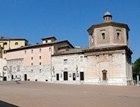

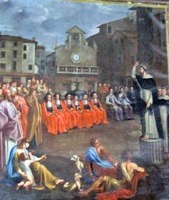
St Peter Martyr preaching in Piazza del Mercato (ca. 1700)
Cappella di San Pietro Martire, San Domenico
The walk begins in Piazza del Mercato, which is situated on a terrace on the hillside at the heart of the city.
-
✴The Roman forum was built here as a rectangular space that extended on a north-south axis. Remains of its paving have been found some 1.5 meters below the present street level.
-
✴This open space seems to have fallen victim to ad hoc urban development from at least the 10th century. The Commune opened up the present piazza in the 13th century, when it was known as Piazza del Foro. It was later named for the weekly market that is still held each Friday.
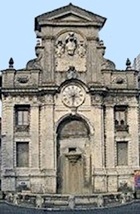
Take a short detour along Via Palazzo dei Duchi, to the left of the fountain:
-
✴the grocer’s shop on the left stands on the foundations of an earlier structure that was wrongly thought to have been the palace of the Dukes of Spoleto, which led to the name of the street.
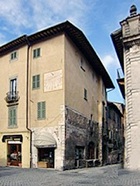
-
✴the shops on the right stand on the clearly visible remains of San Donato.
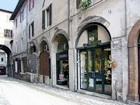
The Roman forum extended to the south as far as the end of Via dei Duchi and the cardo maximus ran south from this point along what is now Via di Fontesecca.
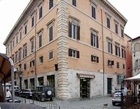
The Arco di Druso ahead marked the end of the Roman forum and the cardo maximus ran north from this point to Arco di Monterone (see below).

Before visiting Palazzo Comunale, continue a little way along Via del Municipio and turn right along Vicolo della Basilica to see the remains of the so-called Roman “basilica” on the left.
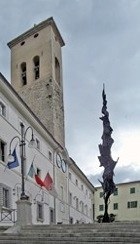
-
✴The entrance to the Roman house that was discovered under Palazzo Comunale in 1885, is at the corner, on the right.
-
✴The western facade of Palazzo Comunale in Via Visiale and the adjoining Palazzo Martelli Orsini are in restoration (at January 2009).
(Palazzo Pagani, Palazzo Martelli Orsini and the Monte di Pietà are described in the page on Palazzo Comunale).
Walk along the right side of Palazzo Comunale (past the Roman house) and turn right into Via Saffi:
-
✴the north facade of Palazzo Comunale, which incorporates the Monte di Pietà, and the civic tower (see below) are on your right; and
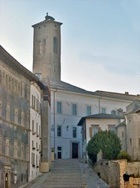
-
✴the south wing of Palazzo Vescovile is on your left. The entrance opens onto its inner courtyard, with facade of Sant' Eufemia on the right. The church is entered from the Museo Diocesano, which occupies the upper floor of the north wing of the palace.
Return to Via Aurelio Saffi and turn left along it to the top of the wide steps of Via dell' Arringo on the left, which lead down to Piazza del Duomo. The covered passage across the street links two parts of Palazzo Pagani (see above).
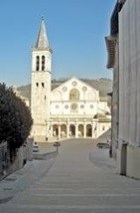
Via dell' Arringo was probably opened up in the late 12th century to link the Duomo to Palazzo Vescovile. It is named for the public assemblies (literally "harangues") that were held in the piazza.
Walk down the steps, past the apse of Sant' Eufemia (see below) is on the left and Palazzo Ràcani Arroni on the right, to Piazza del Duomo. The piazza is laid out on a terrace on the slope of Colle Sant' Elia that was probably established in Roman times and was the site of the episcopal complex of Spoleto from at least the middle of the 10th century.
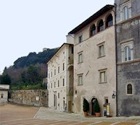
-
✴Casa Fabricolosi (15th century); and
-
✴Palazzo Bufalini (18th century).
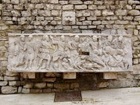
The piazza is closed by the magnificent facade of the Duomo. The Canonica to the left of the Duomo stands on a site donated by Bishop Andrea II to the canons in 1067, when he instituted (or re-organised) the Cathedral Chapter. The original bishop's palace stood behind it, against the city walls, until at least 1173, although it must have been badly damaged during the ravages of the Emperor Frederick I in 1155. The residence was moved to the site of the current Palazzo Vescovile (see below) at some time before 1231.
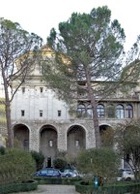
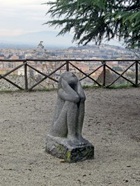
Walk across the facade of Palazzo della Signoria and turn left up Via del Duomo, which leads back into Piazza del Duomo:
-
✴There is an interesting relief of the Virgin in the wall of number 15 on the left.
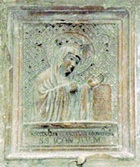
-
✴The entrance after number 29 (i.e. the door to the right in this illustration) leads to the ex- Museo Civico, in Palazzo della Signoria.
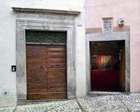
-
✴There is a medieval washing facility at the end, on the right.
-
✴The sculpture (1962) at the top of the steps to the right is called Stranger III and is by Lynn Chadwick.
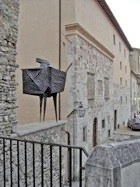
Turn left at the top of the steps. All the buildings on your left stand on the terrace supported by the substructure of the Palazzo della Signoria:
-
✴The Casa dell' Opera del Duomo was built at the far end of the block in 1419.
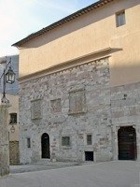
-
✴Two proposals for the rest of the site came to nothing:
-
•one from Bartolomeo della Rovere (a nephew of Pope Sixtus IV and brother of the future Pope Julius II), who planned a palace here in 1478; and
-
•a second from Bishop Costantino Eroli, who planned a public library in 1493.
-
✴A theatre, which later became the Teatro Caio Melisso, was built in the middle in ca. 1664.
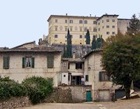
Take a short detour by turning left down the steps of Via dello Spagna: the signed entrance on the left (usually closed) leads to the so-called "Sostruzione Sillane" under Palazzo Vescovile.
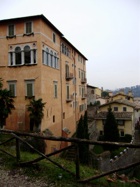

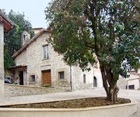
Cross the piazza and down the steps of the narrow vicolo opposite. Turn hard left at the bottom and immediately right along Via Quinto Settano: “Quinto Settano was the pseudonym of the satirist Ludovico Sergardi, who died in Spoleto in 1726.
-
✴The closed church on the right belongs to the Congregazione delle Suore della Sacra Famiglia di Spoleto.
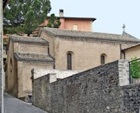
-
✴Their nunnery and interesting museum, the Museo Don Pietro Bonilli, is beyond it, at number 2 on the right. This is housed in part of Casa Eroli, which belonged to Bishop Francesco Eroli in 1500-40.
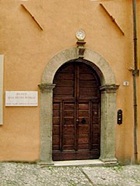
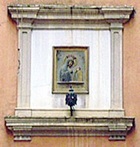
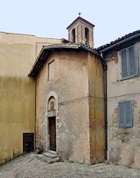
Return along Via Sant’ Alò and ahead up the short Via San Nicolò to the junction with Via Filitteria. The important ex-church of SS Giovanni e Paolo is across the road but the direct access to it (at January 2009) is closed: instead, turn left and immediately right to walk past the lower church to the entrance to the upper church. (You can sometimes arrange to visit the church by speaking to the receptionist at the Galleria Civica d’ Arte Moderna).
Turn left past the facade of the church and right along Via SS Giovanni e Paolo to the junction with Via Minervio, which follows the line of the Roman cardo maximus. Take a short detour by turning right to the junction with Via Filitteria:
-
✴Via Salaria Vecchia, the continuation of the cardo maximus, is opposite. There is an interesting fresco (1375) in the aedicule on the wall of the house opposite (at number 33) that depicts the Madonna and Child enthroned with SS John the Baptist and Bartholomew.
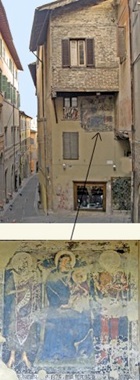
-
✴Teatro Nuovo is to the left, in Via Vaita Sant’ Andrea, which is named for the Monastero di Sant' Andrea, a church and nunnery that was demolished to make way for the theatre. According to tradition, St Thomas a Becket stayed here en route for Rome in the 12th century. A community of Dominican nuns from Santa Caterina della Rosa (near San Domenico) had moved here in 1574 but the complex had been secularised and was used as a residence for old ladies by the early 19th century. This home was demolished in 1840 to make way for the new theatre, at which point its residence moved to the ex-convent of San Paolo inter Vineas.
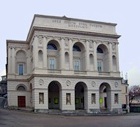
-
✴[Suore della Sacra Famiglia to the right]
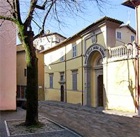
Return to Via Minervio and continue to Piazza Mentana, just before the junction with Corso Mazzini.
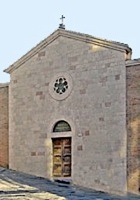
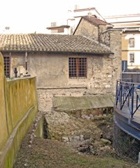
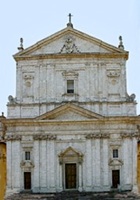
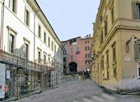
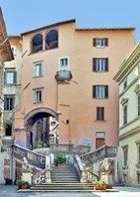
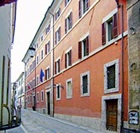
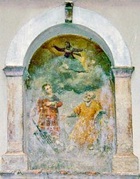
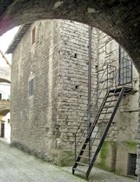
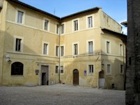
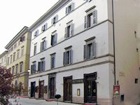
This palace used to house the Pinacoteca Comunale and still contains a few of its pictures. (The most important are now in the Museo del Ducato di Spoleto). It is not clear when and where the rest of the collection will be re-exhibited. The space is now used for the Museo del Tessile e del Costume.
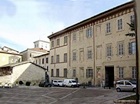
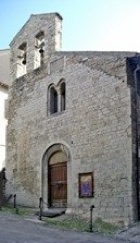
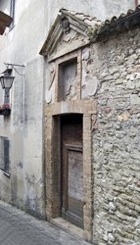
Turn left into Via Sant’ Agata and continue to the junction with Via delle Terme. Take a short detour by turning right for a nice view of the Roman theatre (see below). The street was named “delle Terme” when sporadic finds here before the theatre was excavated led people to the mistaken conclusion that this was the site of the Roman baths . [Palazzo Bartoletti at number 8 contains frescoes (1587) that are the earliest known works by the Perugian artist Benedetto Bandiera.]
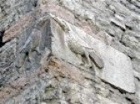
-
✴The portico of Sant' Agata is on the left.
-
✴The entrance to the Museo Archeologico and the Roman theatre is just before it.
-
✴The restaurant opposite, on the corner of Piazza Sant’ Agata, occupies the site of the (now demolished) church of Sant’ Apollinare. A long stretch of Roman wall serves as the foundations of the building to the left of it.
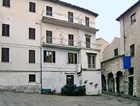
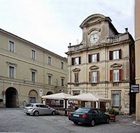
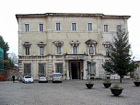
-
✴Cappella di San Benedetto (the Ancaiani family chapel) stood to the left until 1865, when it was demolished to allow the widening of the entrance to Viale Matteotti.
-
✴The arches to the right are all that survives of the stables of the palace, which were demolished in 1954 to facilitate the excavation of the Roman theatre. (There is a fine view of the Roman theatre from here: blocks excavated from the site were re-used in parts of the palace facade, particularly in the part behind the Christmas tree in this picture.
The piazza was in effect the private courtyard of the Ancaiani family from the 13th century until 1820, when they sold their property to the papal authorities. It was named in honour of liberty after the events of 1860: its character changed dramatically in the following decade, when road “improvements” rendered it a major thoroughfare linking Viale Matteotti to Corso Mazzini.

-
✴Piazza Fontana beyond on the left is named for Pietro Fontana, who gave orchards here to the Commune in 1802. The fountain (16th century) came from Piazza Pianciani (above).
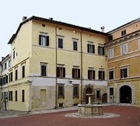
-
✴Palazzo Mauri is on the opposite side of Via Brignone.
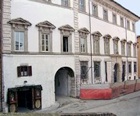
Continue to the junction with Via del Arco di Druso. The Arco di Monterone, the only surviving gate from the Roman walls, is ahead
Turn left before the Arco di Monterone, along Via dell’ Arco di Druso. SS Ansano e Antonio da Padova on the right stands on the foundations of the Roman temple; the entrance Cripta di Sant' Isacco below its tribune is inside the church.
Turn right on leaving Sant’ Ansano and right again along Via del Arco di Druso, which follows the line of the cardo maximus:
-
✴the remains of the right side of the Roman temple are embedded in the left wall of the church; and
-
✴the Arco di Druso ahead marks the northern entrance to the forum (into which the temple originally faced).
Continue into Piazza del Mercato, where the walk ends.
Return to Walks in Spoleto.
